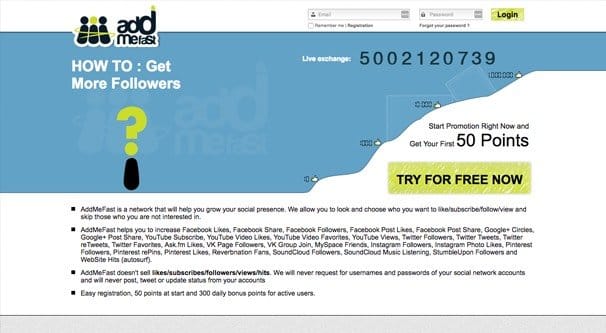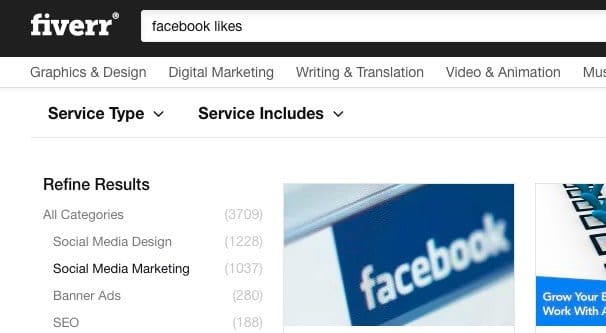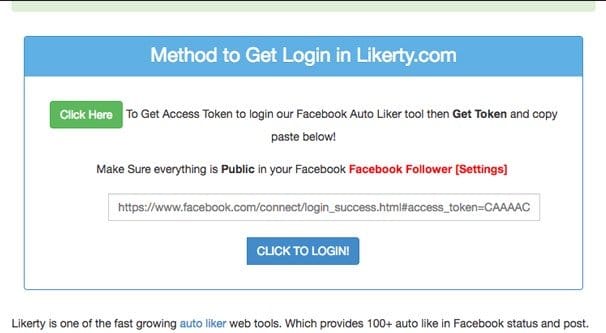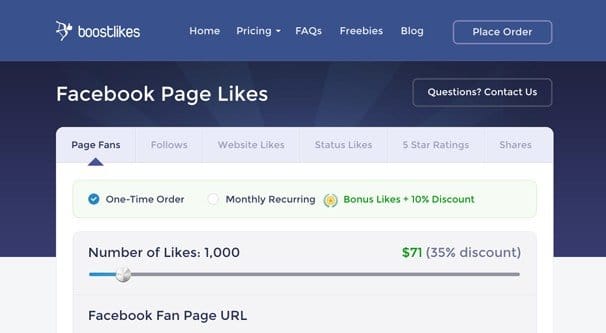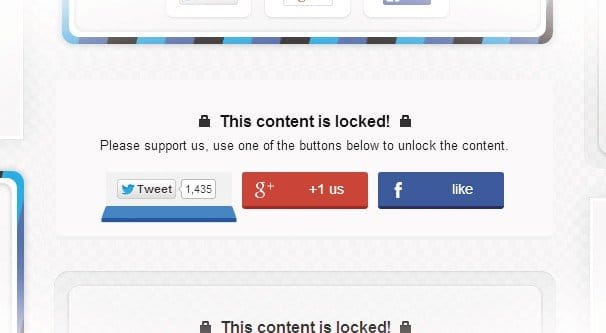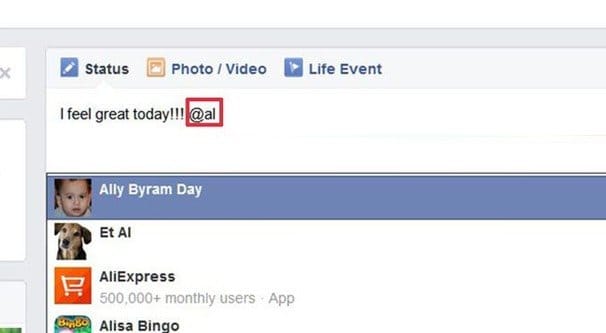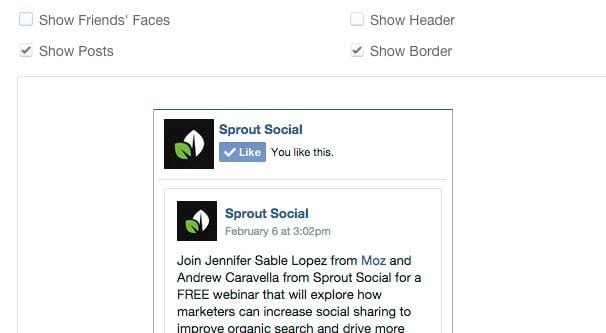 Written by ContentPowered.com
Written by ContentPowered.com
Everyone wants to be a like millionaire on Facebook, but only a select few Facebook pages ever make it to such illustrious heights. And yet, on a social network with over a billion users, you’d think it would be easier to amass engagement. After all, you could get a million likes if just one in a thousand users liked your page.
There are a lot of different ways people use to rack up more likes on their pages. I’ve listed a handful of methods, some bad, some good. I don’t endorse the bad ideas, but I’m telling you about them so you don’t fall into their trap.
Social Media Exchanges
The concept of a social media exchange is just a new adaptation of an old strategy, one that Google has spent a lot of time trying to eliminate when used for traffic and links. In case that doesn’t say it plainly enough, this is one of those bad ideas.
The concept works like this. You visit an exchange network. The network has site owners from all around the world putting their sites – in this case, their Facebook pages and posts – up in rotation. You add your page to the network and it gets views, likes, and shares.
What does the network get out of this? Well, in order to make money, and to build an incentive for users to actually do the browsing and liking, they operate on a credit system. You have to spend credits in order to get your site added to the rotation for X amount of time or X number of views. You can buy credits for cash if you want, or you can browse the network and do the liking yourself in order to earn them. This guarantees a flow of incoming likes in exchange for the traffic they’re providing. They also tend to have a team, generally a clickfarm, working for a minimal fee to do in-house browsing and liking to balance out the people who pay cash rather than likes.
This is, of course, artificial growth. The likes you get come from real people sometimes, or from bots people create to abuse the network, or from clickfarms paid by the network to operate as filler. None of these people really care about your site or your brand. They’re just doing it to get credits so they can get their own pile of worthless garbage likes.
Social media exchanges tend to change names semi-often, but some current ones are AddMeFast and Like4Like. Like4Like is an even more transparently valueless site; they don’t even display content, just a profile picture and a like button, with an associated credit value for that like. They’ll display a big wall of these and you just like for credits and spend credits to appear on the walls of other people. And yes, I’m intentionally not linking to these sites.
Buying Cheap Fiverr Likes
Fiverr sellers will happily sell likes for your page, and the ways they do it are almost as numerous as the sellers.
- Some of them have a network of bot accounts they can command to like a page when you pay them.
- Some of them pay a clickfarm to do the liking for them.
- Some of them throw your site into the autoliker or social media exchange gauntlet.
- Some of them have control of virus-created botnets and hijack real accounts for the likes.
- Some very few of them actually have legitimate promotion methods in their own advertising networks and get you real likes for a premium cost.
The problem with Fiverr is that you’re paying so little that you can’t be guaranteed of any sort of quality.
The same cost in Facebook advertising might only get you a dozen likes, but you can at least be sure that those likes are within your demographics. When you’re paying $5 for 100 or 1,000 likes, you’re getting a lot of crap along with maybe a couple of real likes.
Autolikers
I mentioned this briefly above, so what is it? An autoliker is possibly one of the most exploitative methods possible. It’s basically just a website that has you authenticate their app for your page. The authentication gives them permission to like pages, like content, and even post comments as your page. When you authenticate the app, anyone else who has given them permission will automatically like your page, and you will like theirs. So, if there are 10 people registered with an autoliker and you register, you will get 10 likes and you will like each of those 10 people. Some of them work for pages and others work for specific posts, but they all work the same way. There’s no interaction, no engagement, and often times you have no idea what you’ve even liked or who is liking you.
There’s only one more exploitative method of gaining likes, and that’s using an invisible clickjacker. Those just register the first click anyone makes on your website as a like in a Facebook like box. Think of it as if they’ve made a script that makes a Facebook like button that hovers under your cursor until you’ve clicked it.
Both of these methods are firmly against the Facebook terms of service, and both of them are easily detected. You might as well call them autokillers for how likely they are to kill your page.
Buying Legitimate Likes
Some sites that sell likes, like ours, do so in a much more legitimate manner. They don’t’ use underhanded techniques, fake likes, or clickfarms to generate likes. Essentially, they’re just ad networks or managed Facebook advertisers, buying ads and targeting audiences as per your payment level. If you pay for cheap global traffic, you get cheap global likes. If you pay for more expensive targeted traffic, you get more targeted likes. The tradeoff, of course, is that you’re paying more than for any of the Bad Ideas above.
Buying likes from a site like ours isn’t your only strategy, nor should it be. It can be valuable as a supplement to other forms of audience building, but it’s not ideal as your sole method of growth.
Social Lockers
Social lockers are a more legitimate strategy that nevertheless a lot of people don’t really like using. You tend to see them most often when used on low quality sites that want to artificially inflate their Facebook likes. The idea is generally to hide part or all of your content behind a like gate, forcing users to like your page in order to see the rest of it. You see these as “pay with a like” or “pay with a tweet” plugins as well as the more commonly named social lockers.
The problem with a social locker is two-fold. On the one hand, they’re bad for SEO, because they hide your content from users and from Google. Any method you use to make the content visible to Google will be available to users to reach, so you don’t get the full benefit of the locker. The other problem is that they go against the spirit of what Facebook and other social networks want for likes and engagement. There’s a reason Facebook removed like gates, after all.
Tagging Friends and Influencers
Now on to the more legitimate strategies of organic growth on Facebook. This first one involves needing a lot of friends who aren’t already following your page. All you do, really, is tag people in your posts. Don’t just randomly tag people, but rather tag anyone who might be interested in what you’re posting. The best modern way of doing this is with influencer marketing.
One sample workflow would look something like this. First, write a good blog post. Make sure you cite an influencer in the post, linking to their content as a valuable source. Then, post a link to that newly published blog post on your Facebook page. In that post, tag the page of the site you linked to, to let them know. Chances are they will share your content, like it, and maybe even promote it with their audience, depending on how crucial their contribution was and how much of a big deal you make out of it.
Reviving Messages with Engagement
Reviving messages is a way of taking advantage of Facebook’s algorithm. The way the algorithm works, posts are generally shown with a certain level of preference. Media posts have more preference over non-media posts. Recent posts have preference over older posts. And, most crucially for this method, posts with engagement are given preference over posts without.
Essentially, instead of posting a blog post, link, photograph or whatever more than once, you revive the old post by commenting on it again and sharing it. This gives it a fresh round of exposure, though that exposure will be brief. It does have the added benefit of tagging anyone who commented on it before with a new activity notification.
This method only works once or twice and won’t give you the same exposure as an entirely new post, but it does have the potential to pull in repeat commenters, so it can be valuable nonetheless.
Embed Facebook Boxes
As for a way to encourage more likes from outside of Facebook, what you can do is embed posts in your posts. Look for comments on posts you make and find inspiration for future posts. When you write a future post, embed the Facebook post into your blog post. The embedded post will help attract new engagement on the older post, and can linger as long as that post exists on Facebook. Xzibit will be pleased, eh?
You can also use the Facebook Like Box as a form of embedded content in the framework of your website. Put it on your sidebar and your most recent posts will show up, along with the friends box and other encouragements. It’s optimized by Facebook to be as attractive as possible, as long as you have decent content at the top of your feed.
Link in Offline Advertising
To take things even one step further away from Facebook, you can take your Facebook account offline. Set up a vanity URL if you haven’t – the way you do it is simple – and start posting that URL everywhere. I mean everywhere. It can go in your email signature, posted on the front window of your storefront, printed on your business cards, as a footnote in a bio in a newspaper editorial, in a magazine ad, read aloud in a radio ad or displayed on a TV ad, posted on a billboard, whatever you have the budget for. It should go everywhere.
You can, if you’re a physical storefront of some kind, even give a benefit to people who like your page. Have them show your cashier proof of them liking your page – or authenticating an app, or what have you – and give them an in-store discount.
Buy Facebook Ads
If you’re set on paying money for followers or likes, the easiest way to do it – with the best possible results – is to just pay for Facebook ads. Any third party method is going to be less efficient, assuming that you’ve set up your Facebook ads properly. I’m talking multiple ad sets, plenty of split tests, robust targeting, demographic knowledge, and a lot of thought put into your image and copy.
Yes, it’s a lot of work. Yes, you have the potential to lose a lot of money if you don’t know what you’re doing. At the end of the day, though, a well optimized Facebook ad is going to get you more followers or more post engagement than any of the above methods, or even several of them combined. There’s a reason they’re considered some of the best advertising in the business. You have to be pretty special or have a uniquely incompatible business model to not be able to succeed with Facebook ads.
